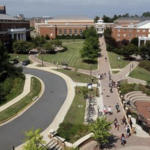by James C. Sherlock
I have previously in this series on Virginia’s public institutions of higher learning (IHE’s) used the term “cannibalization” to describe some getting bigger and some getting smaller, a few much smaller, in terms of student populations.
I will here provide the numbers to back that up.
While the total undergraduates dropped 1.5% (minus 2,572) in the system between the fall of 2018 and the fall of 2022, the increase in graduate students (plus 3,604) made up for it and the total campus population changed 0.4%.
Basically flat.
But those system numbers mask huge swings in student populations, both undergraduate and total, among the 15 schools. The data compiled in that spreadsheet are sourced from the State Council on Higher Education in Virginia (SCHEV).
The trends have enormous consequences for Virginia’s 4-year colleges and universities, both those that are growing and those that are shrinking.
The same trends have easily predicted consequences for Virginia students if not reversed.
Biggest Losers. The big losers in percentage of undergraduate students over that 5-year period were:
- Longwood University — minus 37%
- Radford University — minus 32%
- University of Mary Washington — minus 26%
- UVA College at Wise — minus 19%
- VCU — minus 13%
- VMI — minus 12 %
Eight of the 15 lost undergraduates. The largest losses:
- Virginia Commonwealth minus 2,726
- Radford minus 1,918
- Longwood minus 1,170
- ODU minus 997
- UMW minus 917
In total student loss percentages, the largest were:
- Mary Washington lost graduate students as well as undergraduates, and lost 26% of its total student population in just five years;
- Radford increased graduate students as well, but was still down 21% overall;
- Longwood increased its number of graduate students to get its total losses down to 13%.
In total student numbers:
- VCU — minus 2,668
- Radford — minus 1,617
- ODU — minus 1,069
- UMW — minus 970
- Longwood — minus 553
Biggest winners. The winners in percentages of undergraduates:
- Norfolk State — plus 12.7%
- Virginia Tech — plus 8.6%
- Virginia State — plus 7.3%
- William and Mary — plus 6.2%
In total numbers of undergraduates:
- Virginia Tech — plus 2,623
- George Mason — plus 1,028
- Norfolk State — plus 677
- UVa — plus 581
In percentages of total students:
- Norfolk State — plus 10%
- Virginia Tech — plus 8.7%
- William and Mary — plus 8.7%
- Virginia State –plus 5.7%
In numbers of total students:
- Virginia Tech — plus 3,320
- George Mason — plus 1,930
- UVa — plus 1,240
Cannibalization. Perhaps the only thing all of those schools have in common is in-state tuition for Virginia students. But that is a big one. Many kids are told by their parents that, absent scholarships, they needed to go to a state school.
Among the winners, all increased capacity in the face of flat demand. The result has been cannibalization, whether intended or not.
- Virginia Tech filled its swollen capacity, even using motel rooms to house some undergrads one year while new dorms were finished;
- Ditto UVa, whose undergraduate population increase was exceeded by its increase in grad students;
- George Mason has a lot of commuter students, so increased housing might not be as big a factor there, but they needed the classroom space and instructional staff for the swollen numbers.
Bottom line. The state cannot order students to go to a particular school.
If we want those shifts to continue and gain momentum, the Commonwealth need do nothing.
But we all need to understand that tuition will continue to go up to match the higher costs at the expanding schools. The investments already made into the shrinking schools will continue to lose value.
That will continue to bring with it the consequences to accessibility and to the social and economic costs of student debt.
If Virginia wants to save its smaller state schools, it will need to take action to make them more attractive. Earlier today I offered for consideration a magnet school concept for the smaller schools. There may be better ideas.
But Virginia needs to choose.
